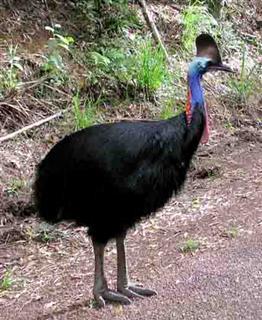Cassowary
Scientific Name: Casuarius casuarius
Fri, 4th July, 2025 - 8:10 am GMT
Sponsor Ads:

Alternative Name
Scientific Name: Casuarius casuariusBasic Info
Reaching up to 5 feet in height, the Cassowary is only average sized for a ratite. They have a bony, gray helmet, which protects them when running through the forest. The skin on the head is pale blue, darkening further down on the neck. They also have some red lateral skin on the neck, as well as two long, red, free-swinging wattles that originate at the front of the neck. The body is black and they have short green-gray or brown-gray legs. The female of the species is usually slightly large and more brightly colored than the male. The female is also more aggressive in nature. Young Cassowaries are downy, with a yellowish-brown body with black stripes. They begin to develop their adult plumage and coloring at about three months. Juvenile Cassowaries have a brownish head and lacks the casque or helmet. Their plumage darkens, as they grow older.
Health
Cassowaries should be kept in enclosures that are in the shade at all times. Otherwise, they are likely to develop cataracts. The pen should include items such as logs, rock, trees and shrubs, especially if the animals are to be bred. This allows the birds to hide from each other and gives them items to nest around. However, except for breeding purposes, they are best kept separate. The enclosure should be at least 200 square meters in size for a breeding pair. Chain link fences are a common boundary, with various types of foliage planted around the boundary to provide shelter for the birds. The height should be at least 1.8 meters to keep the birds from jumping out. The mesh of the fence should be rather small so they can not push their heads out, which can cause damage to the casque and can lead to broken necks. They should not be kept in extremely cold climates. They should have fresh water at all times and should be given the opportunity to swim and play in mud as often as possible. Breeding The breeding season is during May and going through to November. Like other ratites, such as the Emu, the male Cassowary is responsible for rearing the young. Cassowaries lay anywhere from 3-6 large eggs, which could be fertilized by several males. Incubation can take anywhere from 47 to 54 days. When threatened, the male will run away from the nest at a high speed in an attempt to lure away the predator, as the males are quite conspicuous and the eggs blend in with their surroundings. The males not only take care of the eggs, but they tend to the young ones for almost a year.Habitat
Making its home primarily in the rainforest of Northern Queensland, Australia, members of the three species of Cassowaries can also be found in New Guinea and other surrounding islands. In the wild, the Cassowary prefers the banks of streams to other typeBehavior
The Cassowary is a moderately sized member of the ratite family, which also includes ostriches and emus. They are very long lived, with an average lifespan of 61 years if not killed by predators or by destruction of their home. There are only about 1,500 to 3,000 Cassowaries remaining in the world and about forty of these birds are kept in captivity in Australia. . Cassowaries are also threatened by dogs and human predation. The Cassowary feed primarily on fleshy fruit, which they pick from the ground. As the Cassowary digests the seeds of the fruit unharmed, they are an important means of seeding the rainforest. The Cassowary is a very speedy animal. They are capable of running at speeds up to 30 miles per hour, even in dense forest undergrowth.Origin
AustraliaHistory
The Cassowary is a fairly common bird in Australia. While they are becoming scarcer due to deforestation of the rainforests and other predation, there have long been Cassowaries in captivity. The first Cassowary was seen by Europeans in 1596, when one of the birds was given to the captain of a Dutch ship, as a gift by the natives. The captain was later killed by the natives who had given him the Cassowary, but the live bird was taken by the crew back to Amsterdam. It arrived in 1597 and was given to the Holy Emperor Rudolf II. It was displayed for many years. In captivity, Cassowaries have difficulty breeding. In 1862 and 1863 the London Zoo managed to hatch a couple of chicks, but they all died. The first successful rearing of a chick was most likely done by the San Diego Zoo in 1957. The father of this chick, who the zoo had been trying to mate for a very long time, was 31 years old. Various other zoos have successfully bred Cassowaries, with the most successful being the Australian Reptile Park, which raised several chicks between 1973 and 1982 and the Denver Zoo, which has bred 98 chicks since 1977.Common Foods
When fruit is scarce, Cassowaries can eat small, dead marsupials and birds.Sponsor Ads:
We have just enough religion to make us hate, but not enough to make us love one another --Jonathan Swift
Cassowary
Coded by: BGID® | ALL RIGHTS RESERVED Copyright © 2000-2025
Disclaimer | Privacy | Report Errors / Contact | Credits

 President of the United States of America - Real Estate mogul, Pageant owner and now one of the most controversial men in political history.
President of the United States of America - Real Estate mogul, Pageant owner and now one of the most controversial men in political history.  Global warming has been in and out as the "latest" hot topic for many years. It is, according to modern scientists, the result of man-made industrial pollutants, clearing forested areas, agriculture, etc. But now they are thinking it started way before the Industrial Revolution...
Global warming has been in and out as the "latest" hot topic for many years. It is, according to modern scientists, the result of man-made industrial pollutants, clearing forested areas, agriculture, etc. But now they are thinking it started way before the Industrial Revolution...  Politician, US Vice President and President of the USA - Joseph Robinette Biden Jr.
Politician, US Vice President and President of the USA - Joseph Robinette Biden Jr.  versus
versus  Russia: 'The Evil Empire'? Are they all that bad or is it just the USA trying to portray Russia as bad because they are a world power with land bigger and a society very different from the USA ideal?
Russia: 'The Evil Empire'? Are they all that bad or is it just the USA trying to portray Russia as bad because they are a world power with land bigger and a society very different from the USA ideal? 
 Corona virus
Corona virus 
 Users with wide screen monitors can benefit from more content on every page.
Users with wide screen monitors can benefit from more content on every page.